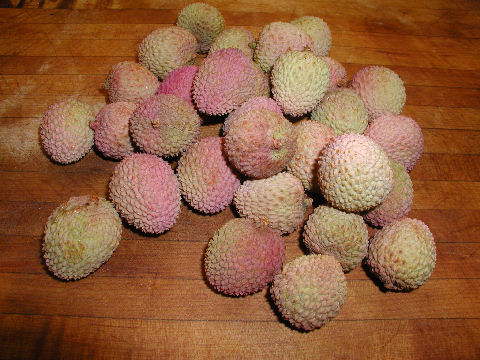“Every ten li a station swirling with dust,
Every five li a post to urge couriers on;
Men die like flies, their corpses line the road,
So that lychees and longans may be delivered to court.
Carriages race over hills, boats sweep through the seas,
With new plucked fruit on fresh boughs, the leaves still dewy,
All to win a smile from the beauty in the palace,
Though it cost bloodshed and strife,
and its effect remains for ever.”– Su Shi, 11th Century Chinese Poet, from A Lament for Lychees

First off, obviously they’re kind of odd looking. The shell is easy to cut through and peel off. Inside the fruit surrounds a very large, slightly poisonous seed that looks something like a giant kidney bean – it easily seems to take up half the space inside (I’m trying to sprout a few of them – who knows, perhaps one day there will be a litchi tree in my garden… though based on my reading it can take 10-12 weeks just to sprout). I can’t tell you which one of the official 42 varieties of litchi this is, other than being fairly certain that it’s not the renowned Zhengcheng Hanging Green, of which there is apparently only one tree remaining, somewhere in Canton province, China.
Litchis are a member of the “soapberry” family, which apparently, having now done a bit of online reading, includes not only things like litchis, longans, and rambutans, but maple and horse chestnut trees as well.
Oh, and the title of the post? From Wikipedia, and neither cited nor verified: There is a Cantonese saying: “one lychee equals three torches of fire”. It refers to the extreme Yang property of the fruit. Over-consumption of lychees is reported to lead to dry lips, nosebleeds, pimples, and mouth ulcers. There have also been reports on Chinese language newspapers on people being sent to hospital for violent nosebleed and/or coughing up blood because of overconsumption of Lychee.
This is news to me… I wonder what, exactly, constitutes “over-consumption”? One ancient Chinese scholar, Su Dongpo, declared that he wouldn’t mind spending his life in exile in Canton province (proclaimed source of the finest litchis) if he could just get to eat 300 litchis a day… He, apparently, wasn’t worried about over-consumption.
Perhaps, but related to an earlier post here, Su Dongpo was obviously one of those fat Asian types, so it may not have bothered him anyway.
If anyone can tell me the address or a location of the Zhengcheng Hanging Greens tree, I will pay money. It is my lifes quest to taste this lychee